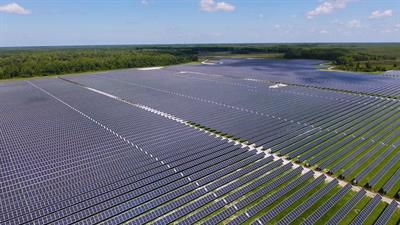Two Central Florida solar farms that are part of one of the largest municipal-backed solar projects in the nation are now operational.
Both the Kissimmee Utility Authority and OUC will be harnessing solar power from the Harmony Solar Energy Center in St. Cloud and the Taylor Creek Solar Energy Center in east Orange County, as part of the Florida Municipal Solar Project.
The Florida Municipal Solar Project is a partnership between the Florida Municipal Power Agency (FMPA) and 16 Florida public power utilities.
“The Florida Municipal Solar Project is a major step in providing affordable, solar energy to our customers. The project is the first major power supply project for FMPA in 30 years, and it’s the first source of solar power for most of the participating cities,” said Ryan Dumas, FMPA spokesman. “More importantly, a large utility-scale project of this size is the most economical way for us to provide affordable solar power to customers.”
Customers of Kissimmee Utility Authority and five other Florida public power utilities are now receiving energy from the two solar farms. It will enable KUA to provide solar power in the most cost-effective way.
The two solar sites generate a total of 149 megawatts of emissions-free energy – enough to power 30,000 homes. KUA is among the first six Florida cities to receive power from the project, utility officials said. One megawatt serves approximately 200 typical residential electric customers in Florida.
There were no up-front costs for the participating municipal electric utilities, and KUA will only pay for the power it purchases.
The group is building five solar farms totaling 1.5 million solar panels that will generate nearly 375 megawatts by the end of 2023. FMPA is the project coordinator.
A total of nearly 600,000 solar panels are installed at the two solar sites, filling about 1,500 acres.
Customers could see a cost savings through the solar power project.
“The cost of solar power from this project is competitive with other forms of energy generation,” said Dumas. “While solar power has not always been the lowest-cost power, it has decreased over time. We expect that trend to continue.”
OUC is adding 108.5 megawatts of green energy to its generation portfolio as two new solar farms begin operations.
OUC will draw all 74.5 megawatts of energy generated by the Taylor Creek Solar Energy Center in east Orange County and 34 megawatts from the 74.5-megawatt Harmony Solar Energy Center in St. Cloud.
OUC officials said the openings also mark a major milestone in OUC’s commitment to achieve net-zero carbon emissions by 2050, with a near-term goal of reducing carbon emissions by 50 percent by 2030 from 2005 levels.
“This is a monumental event in OUC’s nearly 100-year history,” said Clint Bullock, general manager and CEO, referring to the solar farm openings. “We are on our way to becoming a leading solar energy provider on a watts-per-customer basis in Florida. In a few years, we will reach that goal as we expand our solar generation capacity. A cleaner, greener energy future begins here.”
OUC is planning to add an additional 149 megawatts of solar energy, bringing its total solar generation capacity to 270.5 megawatts – enough power for approximately 50,000 typical Florida homes.
In another related development, OUC expects to begin testing a cloud-tracking technology that could predict the impact of cloud coverage over the Taylor Creek and Harmony solar sites. Designed and built by University of Central Florida engineering students, the “sky cams” view clouds and gauge their altitude, density, direction and speed, plus predict how soon they’ll shade a solar farm. This innovation could help OUC anticipate momentary losses of solar power due to clouds, giving other power generation units time to fill the gaps.
“Solar panels do work on cloudy days. They just produce less than normal power output,” said Dumas. “When this occurs, we supply power to customers using other forms of power generation, like our fleet of natural gas power plants that are some of the cleanest of its kind.”
This is the first large utility-scale solar project for FMPA and its members. The 16 local utilities that will purchase power from the project include: Alachua, Bartow, Beaches Energy Services (Jacksonville Beach), Fort Pierce Utilities Authority, Havana, Homestead, Keys Energy Services (Key West), Kissimmee Utility Authority, Lake Worth Beach, Mount Dora, New Smyrna Beach, Newberry, Ocala, Orlando Utilities Commission, Wauchula and Winter Park. These cities are member-owners of FMPA along with 15 other municipal utilities.
“Through this project, we are adding to our already low emissions generation portfolio and meeting customers’ expectations to provide solar energy in the most economical way,” said FMPA’s Jacob Williams, general manager and CEO.
FMPA officials said they encourage Florida residents to install their own solar panels.
“FMPA supports expanding solar for the benefit of all customers. The cost of solar power from this project is one-third the cost of a typical private, rooftop solar system,” said Dumas. “Overall, this is the most economical way for us to provide solar power to our customers.”




